LEO Augmentation Effect on BDS Precise Positioning in High-Latitude Maritime Regions
Abstract
Highlights
- The polar-orbiting LEO constellation increased the average number of visible BDS satellites by 70.2% in high-latitude maritime regions and reduced BDS PPP convergence time from 45.3 min to under 1 min (a 97% improvement), while enhancing three-dimensional positioning accuracy by 54.7% to 0.039 m.
- Incorporation of LEO signals increased the fixed solution success rate of short-baseline BDS RTK from 96.5% to 100%, achieving horizontal and vertical positioning accuracies of 1.1 cm (31.5% enhancement) and 6.4 cm (12.3% enhancement), respectively.
- Utilizing real shipborne BDS data from the Southern Hemisphere’s high-latitude waters, this study empirically demonstrates the enhancement effect of polar-orbiting LEO constellations on GNSS-challenged polar maritime areas, providing a real-time centimeter-level navigation solution to support polar shipping and marine resource exploration.
- The research reveals the differential impacts of LEO constellation types (polar versus medium-inclination orbits) and satellite quantities on BDS precise positioning performance in high-latitude regions, thereby providing critical insights for optimizing orbital configurations of LEO constellations in high-latitude and polar areas.
Abstract
1. Introduction
2. Methodology
2.1. LEO-Augmented BDS PPP Model
2.2. LEO-Augmented BDS RTK Model
2.3. Data Processing Methods
3. Experimental Analysis
3.1. Observation Condition
- Compared to BDS alone, BDS/LEO-L shows an average increase of 7.3 in the number of visible satellites. The integration of LEO effectively enhances the number of satellites visible to the station. The maximum PDOP decreases from 4.9 to 3.4, while the average PDOP improves from 2.4 to 1.7. The high orbital inclination of the polar-orbiting satellites significantly enhances observation conditions in high-latitude regions.
- The maximum and minimum PDOP values for BDS/LEO-M and BDS are identical, with the average PDOP showing a marginal improvement of 0.1. During the observation period, the average number of visible satellites increased by only 0.1.
3.2. LEO-Augmented BDS PPP
3.2.1. Impact of LEO Constellation Type on BDS PPP in High-Latitude Maritime Regions
- In the high-latitude maritime regions of the Southern Hemisphere, BDS alone demonstrates centimeter-level dynamic PPP capability. The convergence time for BDS PPP is approximately 45 min. The Standard Deviations (STD) in the E, N, and U directions are 0.016 m, 0.014 m, and 0.078 m, respectively, while the corresponding Root Mean Square (RMS) values are 0.017 m, 0.017 m, and 0.082 m.
- The integration of LEO satellites significantly shortens the BDS PPP convergence time and effectively enhances positioning accuracy. The convergence time for BDS/LEO is approximately 1 min. The STD values in the E, N, and U directions are 0.013 m, 0.008 m, and 0.028 m, respectively, with RMS values of 0.014 m, 0.008 m, and 0.036 m. The 3D positioning accuracy, represented by STD and RMS, is 0.032 m and 0.039 m, respectively. Compared to BDS-only PPP, the convergence time is improved by 97.8%, while the STD and RMS are enhanced by 60.5% and 54.7%, respectively.
- LEO polar-orbiting satellites play a crucial role in improving PPP performance in high-latitude regions. The convergence time for BDS/LEO-L is 0.95 min, with 3D positioning accuracy (STD and RMS) of 0.032 m and 0.039 m, respectively. In contrast, the convergence time for BDS/LEO-M is 45.3 min, with 3D STD and RMS of 0.081 m and 0.086 m, respectively. Compared to the standalone BDS PPP, the addition of LEO polar-orbiting satellites drastically improves the convergence speed by 98.0%. However, the incorporation of LEO-M does not reduce the PPP convergence time or enhance positioning accuracy. As concluded in the analysis of LEO-M visibility conditions in Section 3.1, under a 10° elevation cutoff, the average number of observable LEO-M satellites in the experimental high-latitude area of the Southern Hemisphere is merely 0.2. Consequently, medium-inclination orbit satellites provide no substantial benefit for PPP performance in high-latitude regions.
3.2.2. Impact of LEO Satellite Count on BDS PPP in High-Latitude Maritime Regions
3.2.3. Impact of LEO Rapid Geometry Variations on BDS PPP Convergence in High-Latitude Maritime Regions
3.3. LEO-Augmented BDS RTK
- In the high-latitude maritime regions of the Southern Hemisphere, the BDS short-baseline RTK achieves three-dimensional positioning accuracy at the sub-meter level, with a fix rate reaching 96.5%. The positioning accuracies in the E, N, and U directions are 0.015 m, 0.007 m, and 0.071 m, respectively, while the horizontal and vertical positioning accuracies are 0.016 m and 0.073 m, respectively.
- The integration of LEO satellites significantly enhances the fix rate of BDS RTK and also improves positioning accuracy to some extent. For BDS/LEO, the positioning accuracies in the E, N, and U directions are 0.009 m, 0.006 m, and 0.063 m, respectively, with corresponding horizontal and vertical accuracies of 0.011 m and 0.064 m. Compared to standalone BDS, the addition of LEO improves the RTK fix rate from 96.5% to 100%, while enhancing horizontal and vertical positioning accuracy by 31.5% and 12.3%, respectively.
4. Discussion
5. Conclusions
- LEO significantly improves the observation conditions in high-latitude regions: Under a 10-degree cutoff elevation angle, the integration of the polar-orbiting LEO constellation increases the average number of visible satellites from 10.4 to 17.7—an improvement of approximately 70.2%—while the average PDOP value improves from 2.4 to 1.7. This markedly enhances the geometry of the satellite constellation. In contrast, the medium-inclination orbit LEO constellation contributed minimally in the experimental area due to its inherent orbital characteristics.
- LEO substantially enhances BDS PPP performance: The incorporation of the full LEO constellation reduced the convergence time of BDS PPP from 45.3 min to less than 1 min—an improvement of over 97%. The three-dimensional positioning accuracy (RMS) improved from 0.086 m to 0.039 m, representing an enhancement of 54.7%. This performance improvement is primarily attributable to the polar-orbiting LEO satellites, whereas the medium-inclination LEO satellites, due to their insufficient visibility, contributed no observable enhancement.
- The number of LEO satellites is a critical factor influencing PPP performance: Segmented PPP experiments demonstrate a negative correlation between the number of LEO satellites involved in the solution and both convergence speed and positioning accuracy. When the average number of LEO satellites during the first two minutes of the convergence phase exceeds 5.4, PPP convergence can be achieved within one minute with positioning accuracy better than 0.2 m. When the number of satellites used in the solution exceeds eight, the convergence time is shortened to within 0.5 min, and positioning accuracy can be improved to 0.1 m. Although further increasing the number of satellites continues to enhance positioning performance, the resulting improvement is not substantial.
- Accelerated convergence via rapid geometric changes from LEO: Under comparable numbers of visible satellites, the BDS/LEO combined PPP achieves convergence in approximately 56 s, significantly faster than the BDS/GPS combination, which requires about 12.15 min. This result directly validates that the rapidly changing sky trajectories of LEO satellites, resulting from their low orbital altitude and high velocity, effectively reduce the correlation among observation equations, thereby enabling rapid (minute-level) convergence
- LEO effectively enhances BDS RTK performance: In short-baseline (<1.7 km) RTK processing, the integration of LEO satellites increased the ambiguity fixed rate from 96.5% to 100%, achieving a fixed solution throughout the entire observation period. Meanwhile, the horizontal positioning accuracy improved from 0.016 m to 0.011 m (a 31.5% enhancement), and the vertical positioning accuracy improved from 0.073 m to 0.064 m (a 12.3% improvement), significantly boosting both the reliability and precision of positioning.
Author Contributions
Funding
Data Availability Statement
Acknowledgments
Conflicts of Interest
References
- Ji, S.; Sun, Z.; Weng, D.; Chen, W.; He, K. High-Precision Ocean Navigation with Single Set of Beidou Short-Message Device. J. Geod. 2019, 93, 1589–1602. [Google Scholar] [CrossRef]
- Järveläinen, A.; Virtanen, J.; Klemetsen, M. Performance of EGNOS in North-East European Latitudes. In Proceedings of the 32nd International Technical Meeting of the Satellite Division of The Institute of Navigation (ION GNSS+ 2019), Miami, FL, USA, 16–20 September 2019; pp. 3105–3118. [Google Scholar]
- Zumberge, J.F.; Heflin, M.B.; Jefferson, D.C.; Watkins, M.M.; Webb, F.H. Precise Point Positioning for the Efficient and Robust Analysis of GPS Data from Large Networks. J. Geophys. Res. Solid Earth 1997, 102, 5005–5017. [Google Scholar] [CrossRef]
- Paziewski, J.; Sieradzki, R. Enhanced Wide-Area Multi-GNSS RTK and Rapid Static Positioning in the Presence of Ionospheric Disturbances. Earth Planets Space 2020, 72, 110. [Google Scholar] [CrossRef]
- Liu, S.; Chen, Y.; Zhang, H. Development of a Low-Cost Smart Sensor GNSS System for Real-Time Positioning and Orientation for Floating Offshore Wind Platforms. Sensors 2023, 23, 925. [Google Scholar]
- Yang, Y.; Mao, Y.; Sun, B. Basic Performance and Future Developments of BeiDou Global Navigation Satellite System. Satell. Navig. 2020, 1, 1. [Google Scholar] [CrossRef]
- Su, K.; Jiao, G. Estimation of BDS Pseudorange Biases with High Temporal Resolution: Feasibility, Affecting Factors, and Necessity. Satell. Navig. 2023, 4, 16. [Google Scholar] [CrossRef]
- Yang, Y.X.; Xu, J.Y. Analysis of the Navigation and Positioning Performance of BeiDou in the Polar Region. Geomat. Inf. Sci. Wuhan Univ. 2016, 41, 15–20. [Google Scholar]
- Reid, T.G.; Neish, A.M.; Walter, T.F.; Enge, P.K. Leveraging Commercial Broadband LEO Constellations for Navigation. In Proceedings of the 29th International Technical Meeting of the Satellite Division of The Institute of Navigation (ION GNSS+ 2016), Portland, OR, USA, 12–16 September 2016; pp. 2300–2314. [Google Scholar]
- Komodromos, Z.M.; Morgan, S.C.; Clements, Z.L.; Qin, W.; Morrison, W.J.; Humphreys, T.E. Network-Aided Pseudorange-Based LEO PNT from OneWeb. In Proceedings of the 2025 IEEE/ION Position, Location and Navigation Symposium (PLANS), Monterey, CA, USA, 28 April–1 May 2025; pp. 1–12. [Google Scholar]
- Li, X.; Lv, H.; Ma, F.; Li, X.; Liu, J.; Jiang, Z. GNSS RTK Positioning Augmented with Large LEO Constellation. Remote Sens. 2019, 11, 228. [Google Scholar] [CrossRef]
- Tian, S.; Dai, W.; Liu, R.; Chang, J.; Li, G. System Using Hybrid LEO-GPS Satellites for Rapid Resolution of Integer Cycle Ambiguities. IEEE Trans. Aerosp. Electron. Syst. 2014, 50, 1774–1785. [Google Scholar] [CrossRef]
- Li, X.; Ma, F.; Li, X.; Lv, H.; Bian, L.; Jiang, Z.; Zhang, X. LEO Constellation-Augmented Multi-GNSS for Rapid PPP Convergence. J. Geod. 2019, 93, 749–764. [Google Scholar] [CrossRef]
- Li, X.; Li, X.; Ma, F.; Yuan, Y.; Zhang, X. Improved PPP Ambiguity Resolution with the Assistance of Multiple LEO Constellations and Signals. Remote Sens. 2019, 11, 408. [Google Scholar] [CrossRef]
- Gao, W.; Zhang, G.; Liu, C.; Lu, J.; Wang, W.; Chen, Y.; Li, M.; Lv, F. Research and Simulation on Navigation Enhancement Capability of LEO Constellation. Sci. Sin. Phys. Mech. Astron. 2021, 51, 079501. [Google Scholar]
- Deng, Z.; Fu, Y.; Li, X. BDS PPP-RTK Positioning Method Enhanced by LEO Satellites and Experimental Analysis. GNSS World China 2023, 48, 57–63. [Google Scholar]
- Hong, J.; Tu, R.; Zhang, P.; Zhang, R.; Han, J.; Fan, L.; Wang, S.; Lu, X. GNSS Rapid Precise Point Positioning Enhanced by Low Earth Orbit Satellites. Satell. Navig. 2023, 4, 11. [Google Scholar] [CrossRef]
- Gao, W.; Xie, X.; Meng, Y.; Li, Q.; Chen, H.; Yang, L.; Geng, T.; Zhao, Q. Performance Analysis of LEO Augmented GNSS Precise Point Positioning from In-Orbit CentiSpace Satellites. Meas. Sci. Technol. 2025, 36, 015001. [Google Scholar] [CrossRef]
- Zhang, X.; Ma, F. Review of the Development of LEO-Enhanced GNSS. Acta Geod. Cartogr. Sin. 2019, 48, 1073–1087. [Google Scholar]
- Li, M.; Huang, T.; Li, W.; Zhao, Q. A Review of the Development of LEO Navigation Enhancement Technology. Geomat. Inf. Sci. Wuhan Univ. 2024, 49, 1–12. [Google Scholar]
- Li, X.; Ge, M.; Dai, X.; Ren, X.; Fritsche, M.; Wickert, J.; Schuh, H. Accuracy and Reliability of Multi-GNSS Real-Time Precise Positioning: GPS, GLONASS, BeiDou, and Galileo. J. Geod. 2015, 89, 607–635. [Google Scholar] [CrossRef]
- Hong, J.; Tu, R.; Liu, Y.; Ge, Y.; Li, F. LEO-Enhanced BDS-3 PPP Performance Based on B2b Signal. Remote Sens. 2025, 17, 2183. [Google Scholar] [CrossRef]
- Ge, H.; Li, B.; Ge, M.; Zang, N.; Nie, L.; Shen, Y.; Schuh, H. Initial Assessment of Precise Point Positioning with LEO Enhanced Global Navigation Satellite Systems (LeGNSS). Remote Sens. 2018, 10, 984. [Google Scholar] [CrossRef]
- Liu, X.; Guo, J.; Li, J.; Xu, S.; Zhao, Q. Ambiguity Resolution Strategy for GPS/LEO Integrated Orbit Determination Based on Regional Ground Stations. Remote Sens. 2025, 17, 1590. [Google Scholar] [CrossRef]
- Li, B.; Miao, W.; Chen, G.; Li, Z. Ambiguity Resolution for Smartphone GNSS Precise Positioning: Effect Factors and Performance. J. Geod. 2022, 96, 63. [Google Scholar] [CrossRef]
- Miao, W.; Li, B.; Gao, Y. The Superiority of Multi-GNSS L5/E5a/B2a Frequency Signals in Smartphones: Stochastic Modelling, Ambiguity Resolution and RTK Positioning. IEEE Internet Things J. 2022, 10, 23149–23160. [Google Scholar] [CrossRef]
- Wu, J.; Wu, S.; Hajj, G.; Bertiger, W.; Lichten, S. Effects of Antenna Orientation on GPS Carrier Phase. Manuscr. Geod. 1993, 18, 91–98. [Google Scholar] [CrossRef]
- Petit, G.; Luzum, B. (Eds.) IERS Conventions (2010); IERS Technical Note No. 36; Verlag des Bundesamts für Kartographie und Geodäsie: Frankfurt am Main, Germany, 2010. [Google Scholar]

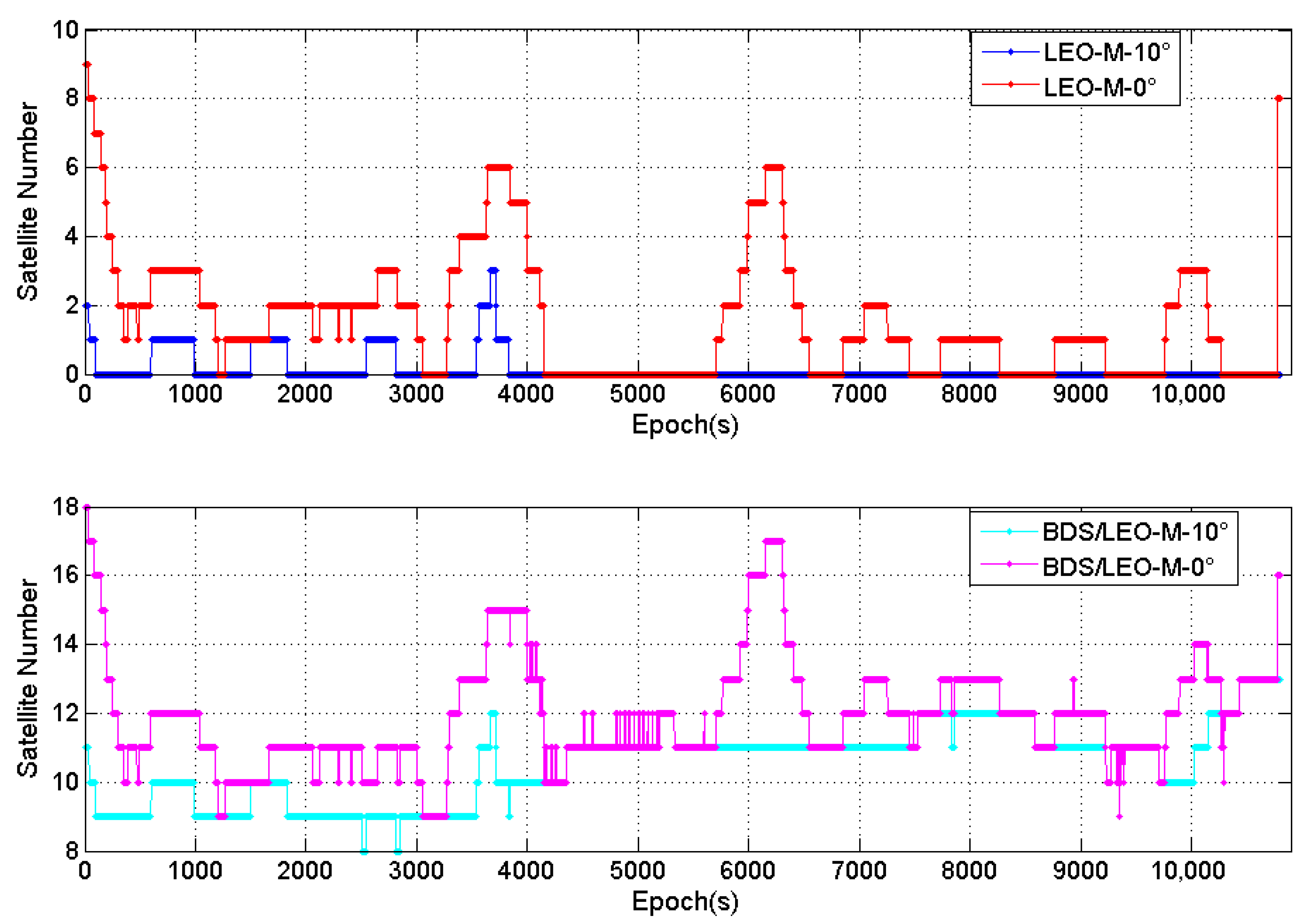


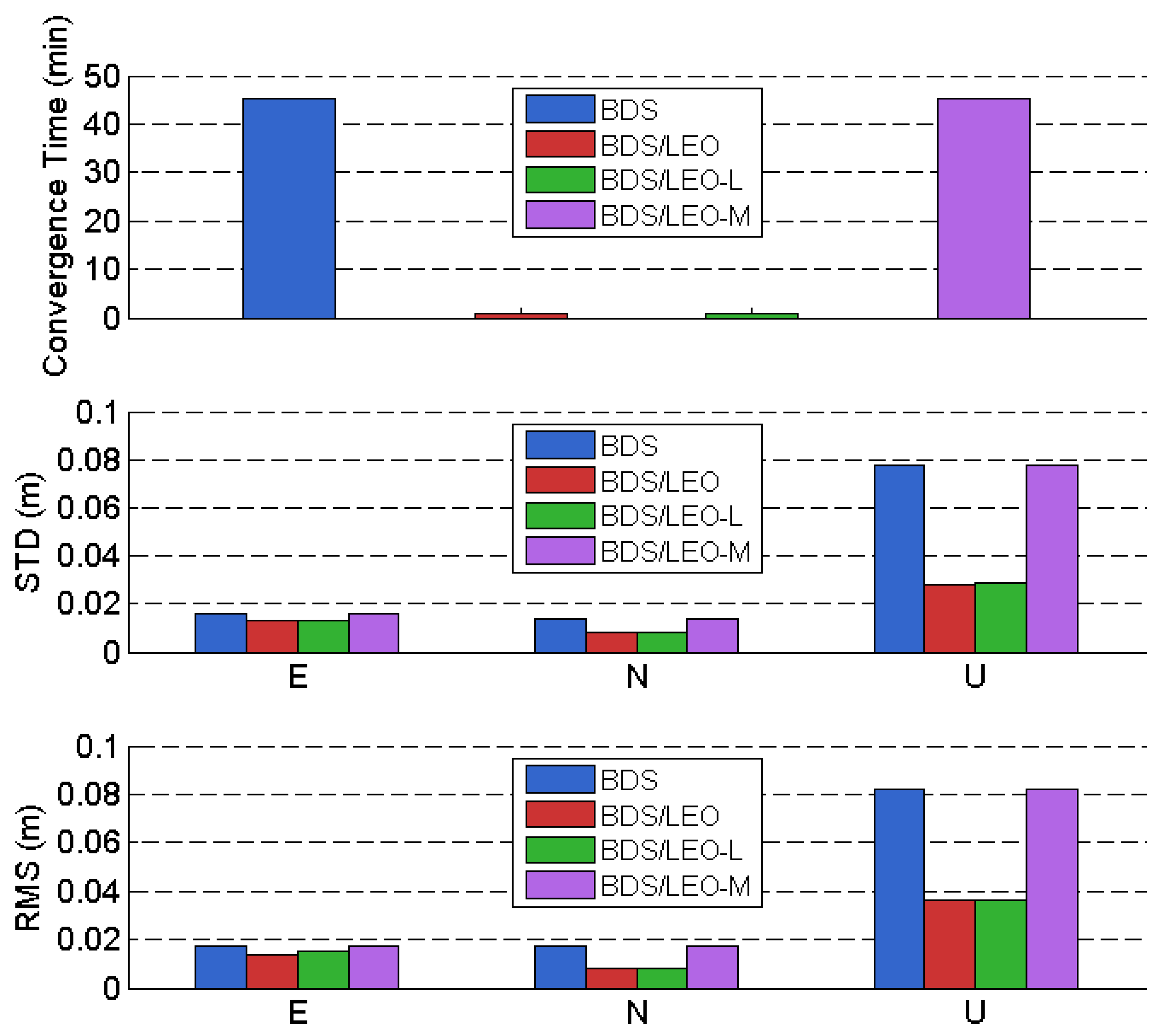

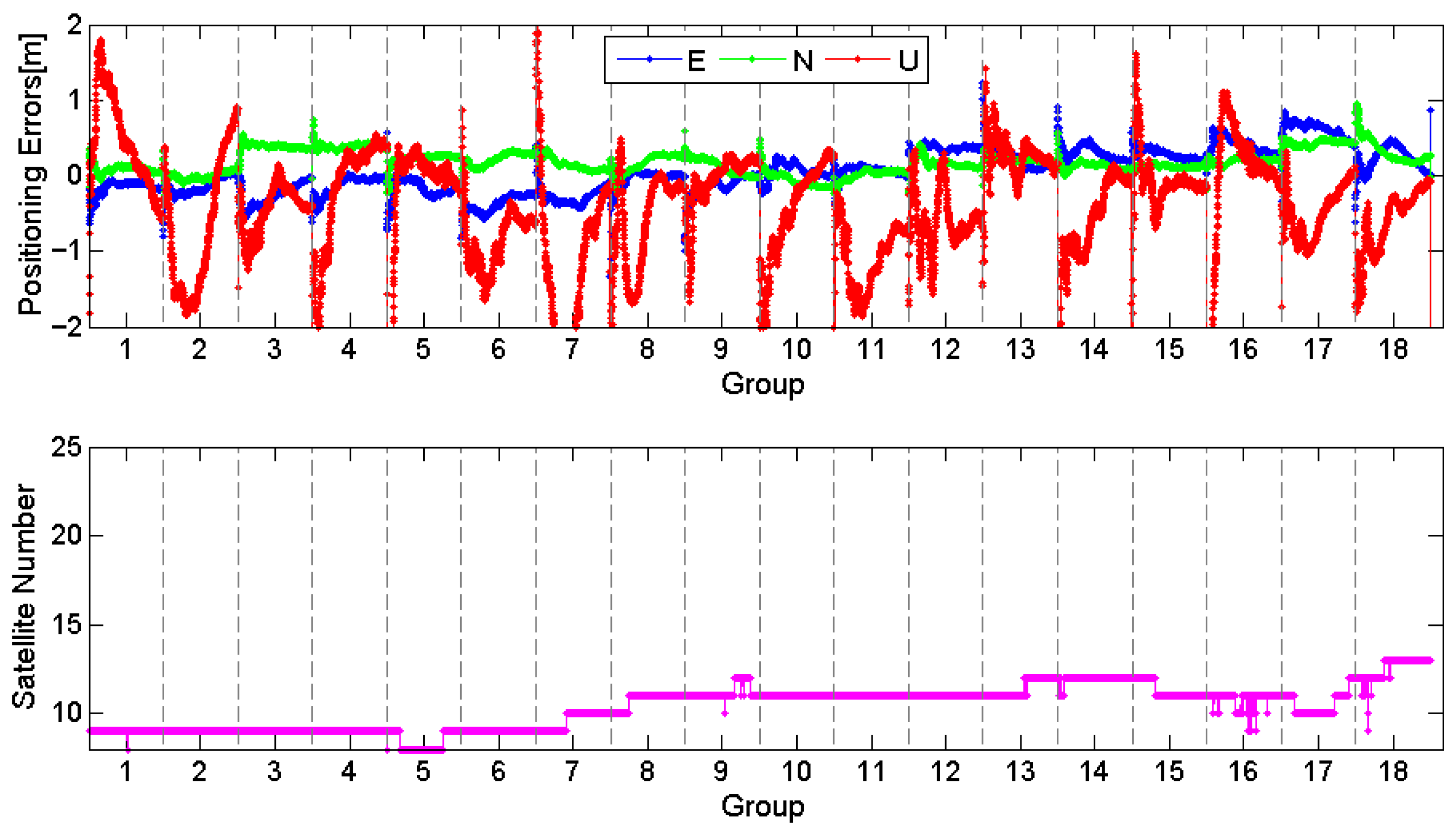





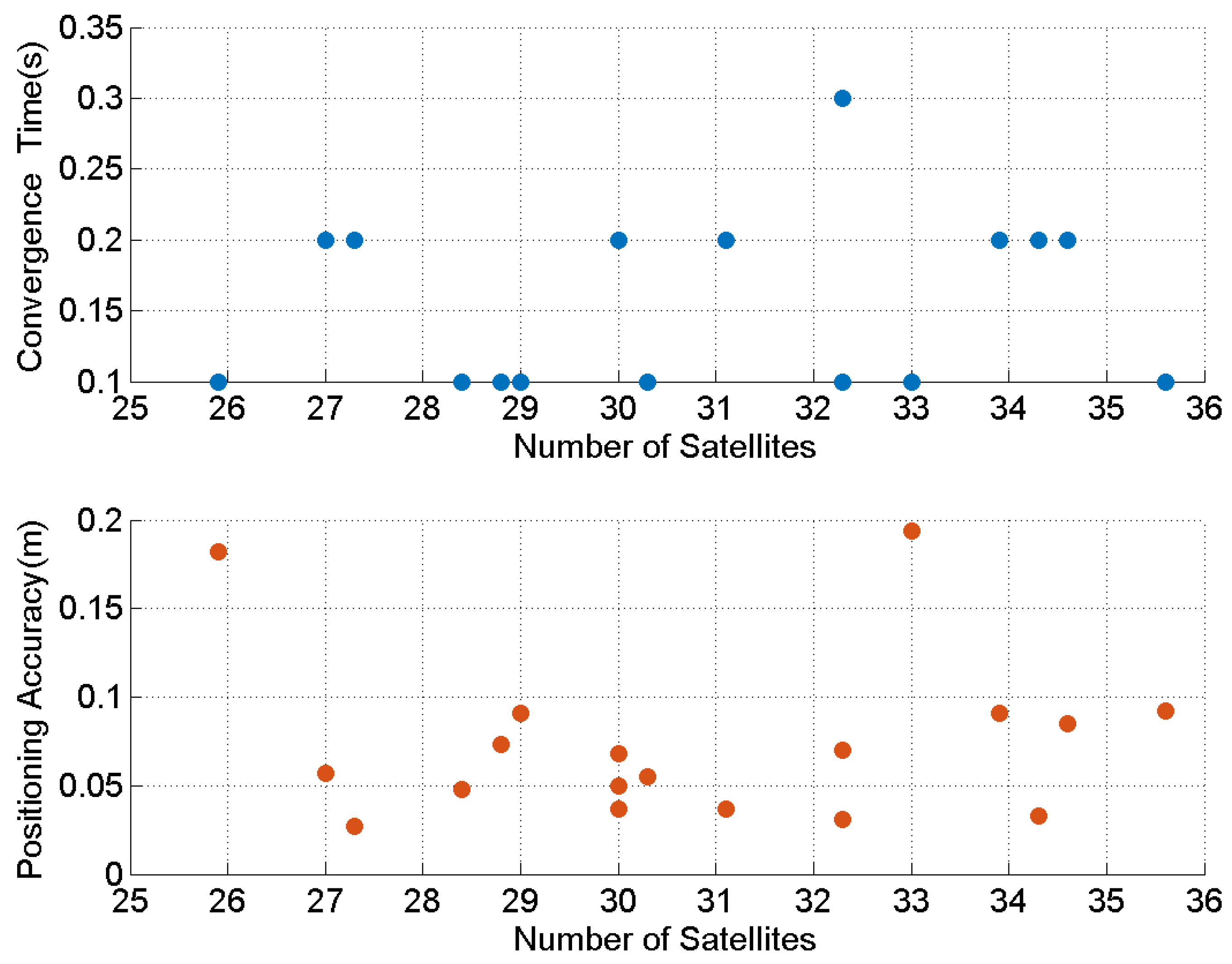
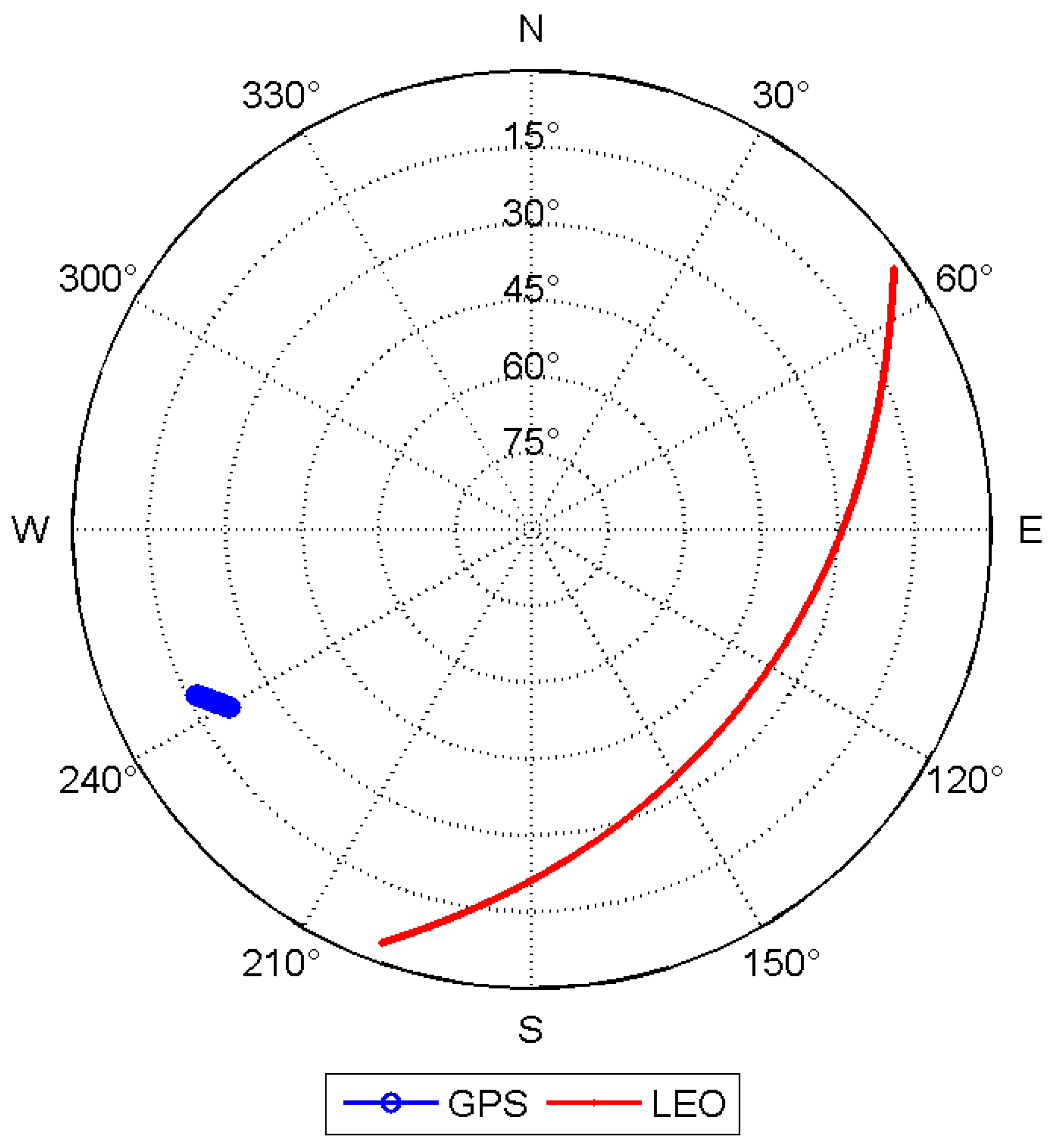


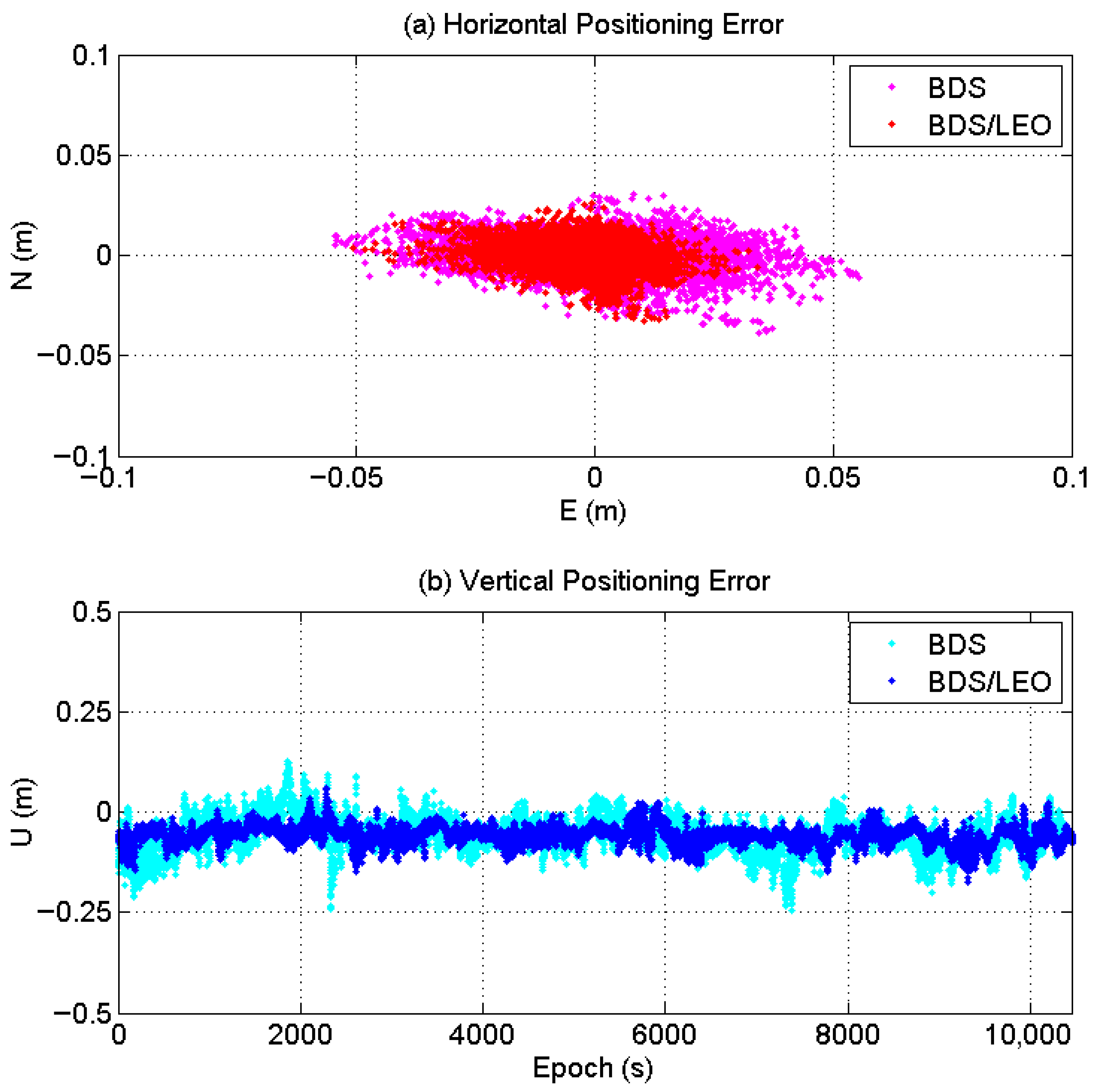
| Parameters | Processing Settings | |
|---|---|---|
| PPP Float Solution | RTK Solution (Short Baseline) | |
| Observations | BDS: B1I/B3I, LEO: L1/L2 | BDS: B1I/B3I, LEO: L1/L2 |
| Sampling rate | 1s | 1s |
| Elevation cutoff | 10° | 10° |
| Observation weight | Elevation dependent weight | Elevation dependent weight |
| Satellite orbit and clock | BDS: WUM precise products, LEO: simulated products | BDS: WUM * precise products, LEO: simulated products |
| Ionosphere delay | First-order eliminated with IF combination | Eliminated by double-difference |
| Satellite PCOs/PCVs | Igs14.atx | Eliminated by double-difference |
| Phase wind-up | Model correct [27] | Model correct [27] |
| Tidal displacements | IERS 2010 [28] | IERS 2010 [28] |
| Earth rotation effect, Relativistic effect, Troposphere dry delay | IERS 2010 [28] | Eliminated by double-difference |
| Estimator | Kalman filtering | Kalman filtering |
| Troposphere wet delay | Estimation, | Eliminated by double-difference |
| Phase ambiguities | Estimation, Constant, Float | Estimation, Constant, Fix, LAMBDA |
| Receiver clock | Estimation, White noise | Eliminated by double-difference |
| Station coordinate | Estimation, Epoch-wise kinematic mode | Estimation, Epoch-wise kinematic mode |
| System | Satellite Number | PDOP | ||||
|---|---|---|---|---|---|---|
| Max | Min | Mean | Max | Min | Mean | |
| BDS | 13 | 8 | 10.4 | 4.9 | 1.6 | 2.4 |
| BDS/LEO-L | 23 | 10 | 17.7 | 3.4 | 1.2 | 1.7 |
| BDS/LEO-M | 13 | 8 | 10.5 | 4.9 | 1.6 | 2.3 |
| Term | LEO-M-10° | LEO-M-0° | BDS/LEO-M-10° | BDS/LEO-M-0° |
|---|---|---|---|---|
| max | 3 | 9 | 13 | 18 |
| min | 0 | 0 | 8 | 9 |
| mean | 0.2 | 1.6 | 10.5 | 11.9 |
| System | Convergence Time (min) | STD 1 (m) | RMS 2 (m) | ||||||
|---|---|---|---|---|---|---|---|---|---|
| E | N | U | 3D | E | N | U | 3D | ||
| BDS | 45.32 | 0.016 | 0.014 | 0.078 | 0.081 | 0.017 | 0.017 | 0.082 | 0.086 |
| BDS/LEO | 0.93 | 0.013 | 0.008 | 0.028 | 0.032 | 0.014 | 0.008 | 0.036 | 0.039 |
| BDS/LEO-L | 0.95 | 0.013 | 0.008 | 0.029 | 0.032 | 0.015 | 0.008 | 0.036 | 0.039 |
| BDS/LEO-M | 45.32 | 0.016 | 0.014 | 0.078 | 0.081 | 0.017 | 0.017 | 0.082 | 0.086 |
| Group | Convergence Time (min) | RMS-3D (m) | LEO Sat Number |
|---|---|---|---|
| 1 | 0.9 | 0.056 | 7.2 |
| 2 | 0.1 | 0.049 | 10.7 |
| 3 | 0.6 | 0.042 | 7.8 |
| 4 | 0.3 | 0.049 | 10.8 |
| 5 | 0.7 | 0.079 | 6.0 |
| 6 | 1.6 | 0.216 | 3.4 |
| 7 | 0.8 | 0.112 | 13.0 |
| 8 | 0.3 | 0.098 | 6.8 |
| 9 | 0.6 | 0.109 | 5.4 |
| 10 | 0.3 | 0.158 | 10.5 |
| 11 | 4.0 | 0.240 | 2.5 |
| 12 | 0.3 | 0.113 | 10.0 |
| 13 | 0.3 | 0.194 | 6.8 |
| 14 | 0.4 | 0.102 | 8.9 |
| 15 | 0.4 | 0.157 | 9.4 |
| 16 | Failed | / | 4.0 |
| 17 | 0.4 | 0.173 | 9.7 |
| 18 | 0.5 | 0.186 | 5.5 |
| Group | Convergence Time (min) | RMS-3D (m) | LEO Sat Number | |||
|---|---|---|---|---|---|---|
| LEO-180 | LEO-288 | LEO-180 | LEO-288 | LEO-180 | LEO-288 | |
| 1 | 0.4 | 0.2 | 0.034 | 0.027 | 18.1 | 28.4 |
| 2 | 0.5 | 0.2 | 0.034 | 0.033 | 20.3 | 33.6 |
| 3 | 0.2 | 0.1 | 0.041 | 0.031 | 19.2 | 31.9 |
| 4 | 0.2 | 0.2 | 0.035 | 0.037 | 19.0 | 31.6 |
| 5 | 0.3 | 0.2 | 0.045 | 0.037 | 18.4 | 30.0 |
| 6 | 0.4 | 0.2 | 0.093 | 0.050 | 17.1 | 29.1 |
| 7 | 0.1 | 0.2 | 0.054 | 0.068 | 19.6 | 30.1 |
| 8 | 0.3 | 0.2 | 0.116 | 0.085 | 21.0 | 34.4 |
| 9 | 0.2 | 0.1 | 0.055 | 0.055 | 21.9 | 29.5 |
| 10 | 0.2 | 0.2 | 0.083 | 0.057 | 16.3 | 27.5 |
| 11 | 0.3 | 0.1 | 0.074 | 0.048 | 19.8 | 28.9 |
| 12 | 0.3 | 0.3 | 0.092 | 0.070 | 20.5 | 32.1 |
| 13 | 0.1 | 0.2 | 0.042 | 0.091 | 21.4 | 34.0 |
| 14 | 0.3 | 0.1 | 0.101 | 0.194 | 19.1 | 32.6 |
| 15 | 0.2 | 0.1 | 0.106 | 0.073 | 17.9 | 28.1 |
| 16 | 0.2 | 0.1 | 0.067 | 0.182 | 16.0 | 26.0 |
| 17 | 0.1 | 0.1 | 0.104 | 0.091 | 18.2 | 29.7 |
| 18 | 0.3 | 0.1 | 0.082 | 0.092 | 20.8 | 34.7 |
| System | Convergence Time (s) |
|---|---|
| BDS/GPS | 56 |
| BDS/LEO | 729 |
| System | Fix Rate (%) | E (m) | N (m) | 2D (m) | U (m) | 3D (m) |
|---|---|---|---|---|---|---|
| BDS | 96.50 | 0.015 | 0.007 | 0.016 | 0.071 | 0.073 |
| BDS/LEO | 100.00 | 0.009 | 0.006 | 0.011 | 0.063 | 0.064 |
Disclaimer/Publisher’s Note: The statements, opinions and data contained in all publications are solely those of the individual author(s) and contributor(s) and not of MDPI and/or the editor(s). MDPI and/or the editor(s) disclaim responsibility for any injury to people or property resulting from any ideas, methods, instructions or products referred to in the content. |
© 2025 by the authors. Licensee MDPI, Basel, Switzerland. This article is an open access article distributed under the terms and conditions of the Creative Commons Attribution (CC BY) license (https://creativecommons.org/licenses/by/4.0/).
Share and Cite
Liu, Y.; Hong, J.; Tu, R.; Wang, S.; Li, F.; Ge, Y.; Su, K. LEO Augmentation Effect on BDS Precise Positioning in High-Latitude Maritime Regions. Remote Sens. 2025, 17, 3220. https://doi.org/10.3390/rs17183220
Liu Y, Hong J, Tu R, Wang S, Li F, Ge Y, Su K. LEO Augmentation Effect on BDS Precise Positioning in High-Latitude Maritime Regions. Remote Sensing. 2025; 17(18):3220. https://doi.org/10.3390/rs17183220
Chicago/Turabian StyleLiu, Yangyang, Ju Hong, Rui Tu, Shengli Wang, Fangxin Li, Yulong Ge, and Ke Su. 2025. "LEO Augmentation Effect on BDS Precise Positioning in High-Latitude Maritime Regions" Remote Sensing 17, no. 18: 3220. https://doi.org/10.3390/rs17183220
APA StyleLiu, Y., Hong, J., Tu, R., Wang, S., Li, F., Ge, Y., & Su, K. (2025). LEO Augmentation Effect on BDS Precise Positioning in High-Latitude Maritime Regions. Remote Sensing, 17(18), 3220. https://doi.org/10.3390/rs17183220





